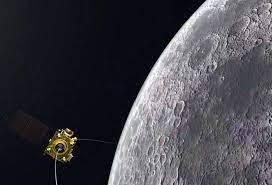Swara Garge, Pune
On September 7, 2019, early in the morning, the mission control room at ISRO’s Telemetry Tracking and Control Centre in Bengaluru fell silent as all contact with the space agency’s Chandrayaan 2 lander Vikram, India’s first attempt to make a soft, robotic landing on the surface of the moon, was lost.
The screens in the mission control room froze up when the Vikram lander was about 335 meters from the surface of the moon, indicating a loss of communication with the lander. Ritu Karidhal, the Chandrayaan 2 mission director, then screamed through the silence, “Please confirm the parameters.” The Deep Space Network earth station near Bengaluru radioed back to mission control, saying, “Braking ended at around two km.”
The images displayed on the huge screen in the mission control center gave the impression that Vikram had lost control and crash-landed on the moon’s surface. However, the project scientists remained hopeful that the Vikram lander on the moon’s surface would send out some sort of signal.
Despite the disaster, there was still optimism in the days that followed that Vikram might send out some kind of signal. On September 12, ISRO reported that the Chandrayaan 2 spacecraft, which was circumnavigating the moon, had discovered the Vikram lander there using its Optical High-Resolution Camera, about five days after the failed landing attempt.
While the Chandrayaan 3 landing attempt on the moon on August 23, 2023, will be closely monitored by mission control at ISTRAC, and the mission scientists, including mission director P Veeramuthuvel, will be unable to intervene if something goes wrong because the entire landing process is controlled during the 15 minutes of descent by computer logic that has already been ingested by the lander’s computers, guidance, and control systems.
However, after the descent phase starts on the evening of August 23 at 17:47 hours for a touchdown at 18:04 hours, mission control will be unable to issue orders to the lander. In essence, the Chandrayaan 3 lander will have to achieve a “safe and soft landing” using its pre-programmed AI.
The navigation, guiding, and control systems on board the lander are another important artificial intelligence system, according to the ISRO Chairman. “This is nothing but computer logic residing in Chandrayaan 3. This is what is steering it to the right position for landing. Whenever the lander has to make decisions on how to go, it is the guidance and control system that will take the lander on the path for landing,” according to Somnath.
